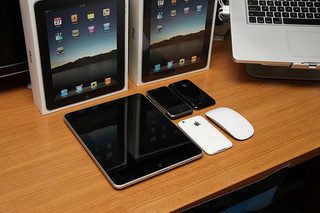 A blog post by Kelsey Battleson
A blog post by Kelsey Battleson
Image Credit: iPad & Friends by Yutaka Tsutano on Flickr
Every morning my commute to work is an hour on average, and within five minutes of my drive, I pass a billboard that every day for two months now has hijacked my train of thought as I finish my commute. On an eye-catching purple background, a clever advertising slogan for Roku is printed: “Christmas, Hanukkah, Kwanzaa. We all worship TV.”
If you haven’t used one yet, a Roku is a small box that you connect to your television that allows you to stream media to your screen. My husband and I have one in our home and even though I once thought we would never use it, this little box has become a staple in our world. What strikes me about this advertisement, though, is not what it says about the actual Roku device (because the billboard tells you nothing about the product itself), but about what this message has to do with the state of our faith and the process of faith formation in societies that heavily use technology.
The thoughts on my drive have included everything from wondering about how television, media, and technology have become idols, to the profound impacts that a rapidly moving digital age has had on our spiritual time and lives, but what I really started to dig into here is actually about a common reality. The witty advertisers of Roku have hit on an interesting truth about many societies no matter the spiritual background you profess, we are united in the tools that we use to engage our interests.
I have been pondering what this means for how we do church, how we do worship, and most often, how we do youth ministry. After weeks of passing this billboard, I have come to one, mostly vague, recurring thought:
If we, as leaders in ministry, aren’t at least interacting with emerging tools (whether on our own or through others’ shared experiences), we may be missing opportunities to connect with people where they are at, simply because we might not know the lingo, the context, or at least the experience of using this tool.
Now the beauty of this thought is that it reinforces our need to connect with people on a face to face level that gives the other an opportunity to share their knowledge and wisdom, and it nearly commands that we be a community that networks. So, as it warms up here in Minnesota and this billboard eventually comes down, I’m left wondering: what does this look like in action in the church?
So, how do/can/should we network our community (leaders, volunteers, participants, other churches even!) to engage with emerging digital tools and then share those resources with one another?
 Author Bio:
Author Bio:
Kelsey Battleson is an 8th and 9th grade coordinator at a large church in the suburbs of the Twin Cities. She is also currently in her final years at Luther Seminary in the Master of Arts Children, Youth, and Family Ministry program and loves working with people, especially emerging adults. In her spare time, what little she has, she plays video and computer games with her husband, crochets and knits for friends and family, and watches repeats of The Big Bang Theory. She is also blogging over at morefunwithtwo.blogspot.com.

